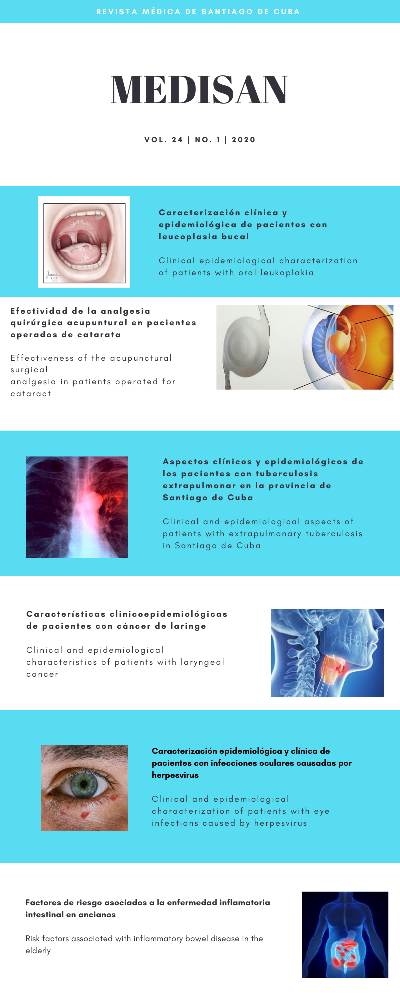Useful considerations for the genetic advice of patients with Ebstein anomaly
Keywords:
Ebstein anomaly, voluntary termination of pregnancy, genetic advice.Abstract
Ebstein anomaly is a strange disease that consists on a variable spectrum of anomalies, due to an abnormal installation of the tricuspid valve in the right ventricle; reason why, it is considered a serious and incurable disorder that originates a tendency to the voluntary termination of pregnancy as reproductive option in the mark of prenatal genetic advice. The advances in the diagnosis and clinical surgical control of this disease have guaranteed the increment of survival and a better life quality in these patients. Also, they have allowed to adjust clinical factors that involve its clinical course and prognosis. Some valuations are carried out, in order to provide the necessary arguments that allow the couple to choose an appropriate action course aimed at the risks and family objectives based on the ethical principles of the genetic advice.
Downloads
References
2. Sánchez DJ, Ferreiro Rodríguez A, Llamos Paneque A, Rodríguez Tur Y, Rizo López D, Yasell Rodríguez M, et al. Comportamiento clínico epidemiológico de los defectos congénitos en La Habana. Rev Cubana Pediatr. 2015 [citado 10/09/2019]; 88 (1). Disponible en: http://www.revpediatria.sld.cu/index.php/ped/article/view/42/24
3. Jordán Ríos A, Magaña Bailón E, Martínez Aguilar M, Maury Ordaz S, Juárez Orozco LE, Jiménez Niño A, et al. Anomalía de Ebstein. Rev Mex Cardiol. 2014 [citado 10/09/2019]; 25 (2). Disponible en: http://www.scielo.org.mx/scielo.php?script=sci_arttext&pid=S0188-21982014000200003
4. Tassinari S, Martínez Vernaza S, Erazo Morera N, Pinzón Arciniegas MC, Gracia G, Zarante I. Epidemiología de las cardiopatías congénitas en Bogotá, Colombia en el período comprendido entre 2001 y 2014: ¿Mejoría en la vigilancia o aumento en la prevalencia?. Biomédica. 2018; 38 (Suppl 1):12-23.
5. Troost E, Roggen L, Goossens E, Moons P, De Meester P, Van De Bruaene A, et al. Cardiopatías congénitas: desde la edad fetal hasta los cuidados paliativos. Int J Cardiol. 2018; (18)34021:0167-5273.
6. Organización Mundial de la Salud. 63a Asamblea Mundial de la Salud. Ginebra, 17 -21 de mayo de 2010: resoluciones y decisiones, anexos. Ginebra: OMS; 2010.
7. Putti P. Defectos congénitos y patologías incompatibles con la vida extrauterina. Rev. Méd. Urug. 2016 [citado 10/09/2019]; 32 (3). Disponible en: http://www.scielo.edu.uy/scielo.php?script=sci_arttext&pid=S1688-03902016000300011
8. Carison LM, Vora NL. Prenatal Diagnosis: screening and diagnosis tools. Obstet Ginecol Clin North Am. 2017; 44 (2): 245-56.
9. Chibas Lamoth Y, Marsillí Rivera Y, Sánchez Ramírez E. Anomalía de Ebstein en diagnóstico prenatal. Rev. Inf. Cient. 2018 [citado 10/09/2019]; 97 (5): 643-51. Disponible en: http://scielo.sld.cu/scielo.php?script=sci_arttext&pid=S1028-99332018000501010&lng=es&nrm=iso
10. Peña Graca J, EM da Cruz, et al. Anomalía de Ebstein. En: Cardiología pediátrica. Nueva York: Springer; 2014 [citado 10/09/2019]. Disponible en: http://scc.org.co/wp-content/uploads/2018/01/ANOMALIA-DE-EBSTEIN-JPPG.pdf
11. Valdés Armenteros R, Ruiz Tellechea Y, Morilla Guzmán A, Domínguez Dieppa F, Díaz Álvarez M, Montes López E, et al. Neonatología. Diagnóstico y tratamiento. 2ed. La Habana: Editorial Ciencias Médicas; 2016.
12. Chaix MA, Andelfinger G, Khairy P. Genetic testing in congenital heart disease: A clinical approach. World J Cardiol. 2016; 8 (2):180-91.
13. Martínez Rubio A, Montes de Oca L, Tissert AI, Peña Castillo B, García Fournier G. Diagnóstico prenatal de cardiopatía congénita. Estudio de dos años. Rev Inf Cient. 2016 [citado 22/09/ 2019]; 95 (3). Disponible en: http://www.revinfcientifica.sld.cu/index.php/ric/article/view/117/2250
Published
How to Cite
Issue
Section
License
All the articles can be downloaded or read for free. The journal does not charge any amount of money to the authors for the reception, edition or the publication of the articles, making the whole process completely free. Medisan has no embargo period and it is published under the license of Creative Commons, International Non Commercial Recognition 4.0, which authorizes the copy, reproduction and the total or partial distribution of the articles in any format or platform, with the conditions of citing the source of information and not to be used for profitable purposes.






